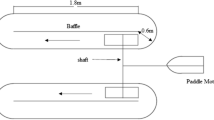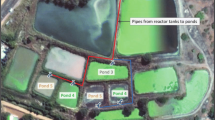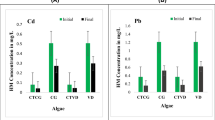Abstract
The increase in freshwater scarcity in developing countries drives to use of poor-quality water for agricultural purposes. The usage of treated sewage for irrigation is increasing worldwide as an alternative resource. But the presence of heavy metals, especially chromium (Cr), resulted in phytotoxicity, low yield and accumulation in the food chain. It leads to detrimental effects on humans and animals. So, efficient eco-friendly remediation techniques are essential to address the current problem. The present investigation aims to treat domestic sewage using biological reactors, then biosorption of total Cr using acclimatized algal species. The efficiency of sewage treatment was observed in terms of chemical & biochemical oxygen demand, total Kjeldahl nitrogen, and ammonia by 92.40 ± 2.21%, 94.70 ± 2.24%, 56.40 ± 17.03% and 80.80 ± 7.80% respectively. Total-Cr presence was 64.20 ± 16.75 mg/L in raw sewage and 55.70 ± 6.70 mg/L in final treated sewage water without algal pond treatment. The algae were acclimatized in metal stress conditions to produce the extracellular polymer for Cr biosorption. After the biosorption in the algal pond, the water contains only 4.41 ± 1.16 mg/L of total Cr with a removal efficiency of 92.00 ± 2.01% in 50 days of monitoring. The Cr-removed treated sewage (CRTS) was reused to cultivate Amaranthus sp. and compared with chromium-containing treated sewage and tap water irrigated plants. The CRTS irrigated plants showed better growth, development and higher protein, carbohydrate and lipid content than others. The algal cell wall offered many functional groups that could bind with Cr ions were confirmed using Fourier transform infrared spectroscopy analysis and proton nuclear magnetic resonance spectroscopy.








Similar content being viewed by others
Data Availability
All data generated or analysed during this study are included in this published article (and its supplementary information files).
References
Acosta, C., Carpio, C., Vilcacundo, R., & Carrillo, W. (2016). Identification of proteins isolate from amaranth (Amaranthus caudatus) by sodium dodecyl sulfate-polyacrylamide gel electrophoresis with water and NaCl 0.1 m solvents. Asian Journal of Pharmaceutical and clinical research, 9(3).
Adeleye, A. S., & Keller, A. A. (2016). Interactions between algal extracellular polymeric substances and commercial TiO2 nanoparticles in aqueous media. Environmental Science and Technology, 50(22), 12258–12265. https://doi.org/10.1021/acs.est.6b03684
Al-Homaidan, A. A., Al-Qahtani, H. S., Al-Ghanayem, A. A., Ameen, F., & Ibraheem, I. B. M. (2018). Potential use of green algae as a biosorbent for hexavalent chromium removal from aqueous solutions. Saudi Journal of Biological Sciences, 25(8), 1733–1738. https://doi.org/10.1016/j.sjbs.2018.07.011
Antúnez-Argüelles, E., Herrera-Bulnes, M., Torres-Ariño, A., Mirón-Enríquez, C., Soriano-García, M., & Robles-Gómez, E. (2020). Enzymatic-assisted polymerization of the lignin obtained from a macroalgae consortium, using an extracellular laccase-like enzyme (Tg-laccase) from Tetraselmis gracilis. Journal of Environmental Science and Health - Part A Toxic/hazardous Substances and Environmental Engineering, 55(6), 739–747. https://doi.org/10.1080/10934529.2020.1738171
Aoki, M., Kowada, T., Hirakata, Y., Watari, T., & Yamaguchi, T. (2020). Enrichment of microbial communities for hexavalent chromium removal using a biofilm reactor. Journal of Environmental Science and Health - Part A Toxic/hazardous Substances and Environmental Engineering, 55(14), 1589–1595. https://doi.org/10.1080/10934529.2020.1826791
APHA. (2017). Standard methods for the examination of water and wastewater (Vol. 1469). APHA, AWWA, WPCR, 1469. https://doi.org/10.2105/SMWW.2882.216
Audu, M., Wang, H., Arellano, D., Cheng, F., Dehghanizadeh, M., Jarvis, J. M., et al. (2021). Ash-pretreatment and hydrothermal liquefaction of filamentous algae grown on dairy wastewater. Algal Research, 57. https://doi.org/10.1016/j.algal.2021.102282
Augustsson, A., Qvarforth, A., Engström, E., Paulukat, C., & Rodushkin, I. (2021). Trace and major elements in food supplements of different origin: Implications for daily intake levels and health risks. Toxicology Reports, 8(January), 1067–1080. https://doi.org/10.1016/j.toxrep.2021.04.012
Bayuo, J. (2021). An extensive review on chromium (vi) removal using natural and agricultural wastes materials as alternative biosorbents. Journal of Environmental Health Science and Engineering, 19(1), 1193–1207. https://doi.org/10.1007/s40201-021-00641-w
Bhuyar, P., Rahim, M. H. A., Maniam, G. P., Ramaraj, R., & Govindan, N. (2020). Exploration of bioactive compounds and antibacterial activity of marine blue-green microalgae (Oscillatoria sp.) isolated from coastal region of west Malaysia. SN Applied Sciences, 2(11), 1–10. https://doi.org/10.1007/s42452-020-03698-8
Cechin, I., & Valquilha, É. M. (2019). Nitrogen effect on gas exchange characteristics, dry matter production and nitrate accumulation of Amaranthus cruentus L. Revista Brasileira de Botanica, 42(3), 373–381. https://doi.org/10.1007/s40415-019-00542-1
Cheah, Y. T., & Chan, D. J. C. (2022). A methodological review on the characterization of microalgal biofilm and its extracellular polymeric substances. Journal of Applied Microbiology, 132(5), 3490–3514. https://doi.org/10.1111/jam.15455
Chowdhury, P. (2009). Polymers for the extraction of chromium—role of polymers in the removal and recovery of chromium from wastewater. Journal of Macromolecular Science, Part A, 46(10), 1030–1038. https://doi.org/10.1080/10601320903158784
CPCB. (1986). General standards for discharge of environmental pollutants. The Environment (Protection) Rules, 2(174), 545–560.
Daneshvar, E., Zarrinmehr, M. J., Kousha, M., Hashtjin, A. M., Saratale, G. D., Maiti, A., et al. (2019). Hexavalent chromium removal from water by microalgal-based materials: Adsorption, desorption and recovery studies. Bioresource Technology, 293(June), 122064. https://doi.org/10.1016/j.biortech.2019.122064
Elahi, A., Arooj, I., Bukhari, D. A., & Rehman, A. (2020). Successive use of microorganisms to remove chromium from wastewater. Applied Microbiology and Biotechnology, 104(9), 3729–3743. https://doi.org/10.1007/s00253-020-10533-y
El-Sikaily, A., Nemr, A. E., Khaled, A., & Abdelwehab, O. (2007). Removal of toxic chromium from wastewater using green alga Ulva lactuca and its activated carbon. Journal of Hazardous Materials, 148(1–2), 216–228. https://doi.org/10.1016/j.jhazmat.2007.01.146
Fernández, P. M., Viñarta, S. C., Bernal, A. R., Cruz, E. L., & Figueroa, L. I. C. (2018). Bioremediation strategies for chromium removal: Current research, scale-up approach and future perspectives. Chemosphere, 208, 139–148. https://doi.org/10.1016/j.chemosphere.2018.05.166
Filippini, T., Cilloni, S., Malavolti, M., Violi, F., Malagoli, C., Tesauro, M., et al. (2018). Dietary intake of cadmium, chromium, copper, manganese, selenium and zinc in a Northern Italy community. Journal of Trace Elements in Medicine and Biology, 50, 508–517. https://doi.org/10.1016/j.jtemb.2018.03.001
Ghosh, S., Jasu, A., & Ray, R. R. (2021). Hexavalent chromium bioremediation with insight into molecular aspect: An overview. Bioremediation Journal, 25(3), 225–251. https://doi.org/10.1080/10889868.2021.1884529
Gogoi, M., & Basumatary, M. (2018). Estimation of the chlorophyll concentration in seven Citrus species of Kokrajhar district, BTAD, Assam, India. Tropical Plant Research, 5(1), 83–87. https://doi.org/10.22271/tpr.2018.v5.i1.012
Gongi, W., Cordeiro, N., Pinchetti, J. L. G., Sadok, S., & Ben Ouada, H. (2021). Extracellular polymeric substances with high radical scavenging ability produced in outdoor cultivation of the thermotolerant chlorophyte Graesiella sp. Journal of Applied Phycology, 33(1), 357–369. https://doi.org/10.1007/s10811-020-02303-0
Hamilton, E. M., Young, S. D., Bailey, E. H., & Watts, M. J. (2018). Chromium speciation in foodstuffs: A review. Food Chemistry, 250(Vi), 105–112. https://doi.org/10.1016/j.foodchem.2018.01.016
Hanjra, M. A., Blackwell, J., Carr, G., Zhang, F., & Jackson, T. M. (2012). Wastewater irrigation and environmental health: Implications for water governance and public policy. International Journal of Hygiene and Environmental Health, 215(3), 255–269. https://doi.org/10.1016/j.ijheh.2011.10.003
Hidalgo-morales, M., & Tsopmo, A. (2020). Characterization of Amaranthus hypochondriacus seed protein fractions, and their antioxidant activity after hydrolysis with lactic acid bacteria. 95(August). https://doi.org/10.1016/j.jcs.2020.103075
Hossain, M. N., Sarker, U., Raihan, M. S., Al-Huqail, A. A., Siddiqui, M. H., & Oba, S. (2022). Influence of salinity stress on color parameters, leaf pigmentation, polyphenol and flavonoid contents, and antioxidant activity of amaranthus lividus leafy vegetables. Molecules, 27(6). https://doi.org/10.3390/molecules27061821
Jobby, R., Jha, P., Yadav, A. K., & Desai, N. (2018). Biosorption and biotransformation of hexavalent chromium [Cr(VI)]: A comprehensive review. Chemosphere, 207(Vi), 255–266. https://doi.org/10.1016/j.chemosphere.2018.05.050
Kadeem, E. J. (2011). Identification and Quantitative Estimation of Lutein in Iraqi Spinacia oleraceaFamily Chenopodiaceae by Using Chromatographic Methods. Baghdad Science Journal, 8(1).
Koçer, A. T., İnan, B., Kaptan Usul, S., Özçimen, D., Yılmaz, M. T., & Işıldak, İ. (2021). Exopolysaccharides from microalgae: Production, characterization, optimization and techno-economic assessment. Brazilian Journal of Microbiology, 52(4), 1779–1790. https://doi.org/10.1007/s42770-021-00575-3
Kumaraguru, K., Saravanan, P., Rajesh kannan, R., & Saravanan, V. (2021). A systematic analysis of hexavalent chromium adsorption and elimination from aqueous environment using brown marine algae (Turbinaria ornata). Biomass Conversion and Biorefinery, 2021, 1–16. https://doi.org/10.1007/S13399-021-01795-1
Li, J., Yan, L., Yang, Y., Zhang, X., Zhu, R., & Yu, H. (2019). Insight into the adsorption mechanisms of aqueous hexavalent chromium by EDTA intercalated layered double hydroxides: XRD, FTIR, XPS, and zeta potential studies. New Journal of Chemistry, 43(40), 15915–15923. https://doi.org/10.1039/C9NJ03479J
Maaß, O., & Grundmann, P. (2018). Governing transactions and interdependences between linked value chains in a circular economy: the case of wastewater reuse in Braunschweig (Germany). 1–29. https://doi.org/10.3390/su10041125
Maharaja, M., Judia Magthalin, C., Mahesh, M., Sunkapur, L. K., & Swarnalatha, S. (2017). Treatment of tannery saline wastewater by using effective immobilized protease catalyst produced from salt tolerant Enterococcus feacalis. Journal of Environmental Chemical Engineering, 5(2), 2042–2055. https://doi.org/10.1016/j.jece.2017.04.014
Mahesh, P., Villalan, A. K., Jothieswari, M., Somasundaram, S., & Ganesan, S. (2017). An innovative approach to minimize excess sludge production in sewage treatment using integrated bioreactors. Journal of Environmental Sciences, 67, 67–77. https://doi.org/10.1016/j.jes.2017.07.020
Mannacharaju, M., Natarajan, P., Villalan, A. K., Jothieswari, M., Somasundaram, S., & Ganesan, S. (2018). An innovative approach to minimize excess sludge production in sewage treatment using integrated bioreactors. Journal of Environmental Sciences, 67, 67–77. https://doi.org/10.1016/j.jes.2017.07.020
Mishra, M. K. (2016). Fourier transform infrared spectrophotometry studies of chromium trioxide-phthalic acid complexes. Chemical Science Transactions, 5(3), 770–774. https://doi.org/10.7598/cst2016.1260
Mishra, S., & Bharagava, R. N. (2016). Toxic and genotoxic effects of hexavalent chromium in environment and its bioremediation strategies. Journal of Environmental Science and Health - Part C Environmental Carcinogenesis and Ecotoxicology Reviews, 34(1), 1–32. https://doi.org/10.1080/10590501.2015.1096883
Munawaroh, H. S. H., Gumilar, G. G., Alifia, C. R., Marthania, M., Stellasary, B., Yuliani, G., et al. (2020). Photostabilization of phycocyanin from Spirulina platensis modified by formaldehyde. Process Biochemistry, 94(April), 297–304. https://doi.org/10.1016/j.procbio.2020.04.021
Nasr, F. A., El-Shafai, S. A., Abdelfadil, A. S., Ibrahim, H. S., & Hemdan, B. A. (2019). Potential use of treated domestic sewage for cultivation of biofuel crops in Egypt. International Journal of Environmental Science and Technology, 16(11), 7433–7442. https://doi.org/10.1007/s13762-018-2101-4
Natarajan, P., Jayavel, K., Somasundaram, S., & Ganesan, S. (2020). Integrated catalytic oxidation and biological treatment of spent caustic wastewater discharged from petrochemical industries. Energy, Ecology and Environment. https://doi.org/10.1007/s40974-020-00178-y
Nithya, K., Sathish, A., Pradeep, K., & Kiran Baalaji, S. (2019). Algal biomass waste residues of Spirulina platensis for chromium adsorption and modeling studies. Journal of Environmental Chemical Engineering, 7(5), 103273. https://doi.org/10.1016/J.JECE.2019.103273
Nouha, K., Kumar, R. S., Balasubramanian, S., & Tyagi, R. D. (2018). Critical review of EPS production, synthesis and composition for sludge flocculation. Journal of Environmental Sciences, 66, 225–245. https://doi.org/10.1016/j.jes.2017.05.020
Nübler, S., Schäfer, M., Haji-Abbas-Zarrabi, K., Marković, S., Marković, K., Esteban López, M., et al. (2022). Interlaboratory Comparison Investigations (ICIs) for human biomonitoring of chromium as part of the quality assurance programme under HBM4EU. Journal of Trace Elements in Medicine and Biology, 70, 126912. https://doi.org/10.1016/j.jtemb.2021.126912
Nur-E-Alam, M., Mia, M. A. S., Ahmad, F., & Rahman, M. M. (2020). An overview of chromium removal techniques from tannery effluent. Applied Water Science, 10(9), 1–22. https://doi.org/10.1007/s13201-020-01286-0
Pagi, N., Prajapati, N., Pachchigar, K., Dharajiya, D., Solanki, S. D., Soni, N., & Patel, P. (2017). GGE biplot analysis for yield performance of grain Amaranth genotypes across different environments in western India. Journal of Experimental Biology and Agricultural Sciences, 5(3), 368–367. https://doi.org/10.18006/2017.5(3).368.376
Peng, H., & Guo, J. (2020). Removal of chromium from wastewater by membrane filtration, chemical precipitation, ion exchange, adsorption electrocoagulation, electrochemical reduction, electrodialysis, electrodeionization, photocatalysis and nanotechnology: a review. Environmental Chemistry Letters. https://doi.org/10.1007/s10311-020-01058-x. (Springer International Publishing).
Pradhan, D., Sukla, L. B., Mishra, B. B., & Devi, N. (2019). Biosorption for removal of hexavalent chromium using microalgae Scenedesmus sp. Journal of Cleaner Production, 209, 617–629. https://doi.org/10.1016/j.jclepro.2018.10.288
Promdaen, S., Wattuya, P., & Sanevas, N. (2014). Automated microalgae image classification. Procedia Computer Science, 29, 1981–1992. https://doi.org/10.1016/j.procs.2014.05.182
Ratha, S. K., Prasanna, R., Gupta, V., Dhar, D. W., & Saxena, A. K. (2012). Bioprospecting and indexing the microalgal diversity of different ecological habitats of India. World Journal of Microbiology and Biotechnology, 28(4), 1657–1667. https://doi.org/10.1007/s11274-011-0973-2
Rathod, K. J., Jadeja, B. A., & Nakar, R. N. (2021). Morphological, biochemical and molecular characterization of Amaranthus varieties in India. Proceedings of the National Academy of Sciences India Section B - Biological Sciences. https://doi.org/10.1007/s40011-021-01251-0
Santhosh, S., Rajalakshmi, A. M., Navaneethakrishnan, M., Jenny Angel, S., & Dhandapani, R. (2020). Lab-scale degradation of leather industry effluent and its reduction by Chlorella sp. SRD3 and Oscillatoria sp. SRD2: A bioremediation approach. Applied Water Science, 10(5), 112. https://doi.org/10.1007/s13201-020-01197-0
Sarker, U., Hossain, M. M., & Oba, S. (2020a). Nutritional and antioxidant components and antioxidant capacity in green morph Amaranthus leafy vegetable. Scientific Reports, 10(1), 1–10. https://doi.org/10.1038/s41598-020-57687-3
Sarker, U., Islam, M. T., Rabbani, M. G., & Oba, S. (2017). Genotypic diversity in vegetable amaranth for antioxidant, nutrient and agronomic traits. Indian Journal of Genetics and Plant Breeding, 77(1), 173–176. https://doi.org/10.5958/0975-6906.2017.00025.6
Sarker, U., Oba, S., & Daramy, M. A. (2020b). Nutrients, minerals, antioxidant pigments and phytochemicals, and antioxidant capacity of the leaves of stem amaranth. Scientific Reports, 10(1), 1–9. https://doi.org/10.1038/s41598-020-60252-7
Satapathy, S., Shukla, S. P., Sandeep, K. P., Singh, A. R., & Sharma, N. (2015). Evaluation of the performance of an algal bioreactor for silver nanoparticle production. Journal of Applied Phycology, 27(1), 285–291. https://doi.org/10.1007/s10811-014-0311-9
Shahadat, M., Rafatullah, M., & Teng, T. T. (2015). Characterization and sorption behavior of natural adsorbent for exclusion of chromium ions from industrial effluents. Desalination and Water Treatment, 53(5), 1395–1403. https://doi.org/10.1080/19443994.2013.855678
Sharma, A., Kapoor, D., Wang, J., Shahzad, B., Kumar, V., Bali, A. S., et al. (2020). Chromium bioaccumulation and its impacts on plants: An overview. Plants, 9(1), 1–17. https://doi.org/10.3390/plants9010100
Shobier, A. H., El-Sadaawy, M. M., & El-Said, G. F. (2020). Removal of hexavalent chromium by ecofriendly raw marine green alga Ulva fasciata: Kinetic, thermodynamic and isotherm studies. Egyptian Journal of Aquatic Research, 46(4), 325–331. https://doi.org/10.1016/j.ejar.2020.09.003
Singh, S., Kumar, V., Datta, S., Dhanjal, D. S., Sharma, K., Samuel, J., & Singh, J. (2020). Current advancement and future prospect of biosorbents for bioremediation. Science of the Total Environment, 709, 135895. https://doi.org/10.1016/j.scitotenv.2019.135895
Swarnalatha, S., Vinayagamoorthy, N., & Sekaran, G. (2022). Municipal Wastewater—A Remedy for Water Stress in India (pp. 185–211). Springer. https://doi.org/10.1007/978-3-030-95786-5_10
Tsuchiyama, T., Tazaki, A., Al Hossain, M. A., Yajima, I., Ahsan, N., Akhand, A. A., et al. (2020). Increased levels of renal damage biomarkers caused by excess exposure to trivalent chromium in workers in tanneries. Environmental Research, 188(June), 109770. https://doi.org/10.1016/j.envres.2020.109770
Vaiopoulou, E., & Gikas, P. (2012). Effects of chromium on activated sludge and on the performance of wastewater treatment plants: A review. Water Research, 46(3), 549–570. https://doi.org/10.1016/j.watres.2011.11.024
Venkatesan, P., & Sathiavelu, M. (2022). Effective kinetic modeling and phycoremediation of Cr(IV) ions from tannery effluent by using microalgae–Chlamydomonas moewusii, Auxenochlorella pyrenoidosa, Scenedesmus sp. Bioremediation Journal, 0(0), 1–20. https://doi.org/10.1080/10889868.2022.2040413
Wang, Q., Zhou, C., Kuang, Y.-j, Jiang, Z.-h, & Yang, M. (2020). Removal of hexavalent chromium in aquatic solutions by pomelo peel. Water Science and Engineering, 13(1), 65–73. https://doi.org/10.1016/j.wse.2019.12.011
Yang, X., Zhao, Z., Yu, Y., Shimizu, K., Zhang, Z., Lei, Z., & Lee, D. J. (2020). Enhanced biosorption of Cr(VI) from synthetic wastewater using algal-bacterial aerobic granular sludge: Batch experiments, kinetics and mechanisms. Separation and Purification Technology, 251(July), 117323. https://doi.org/10.1016/j.seppur.2020.117323
Younas, F., Niazi, N. K., Bibi, I., Afzal, M., Hussain, K., Shahid, M., et al. (2022). Constructed wetlands as a sustainable technology for wastewater treatment with emphasis on chromium-rich tannery wastewater. Journal of Hazardous Materials. https://doi.org/10.1016/j.jhazmat.2021.126926
Zhang, Y., & Shen, Y. (2017). Wastewater irrigation: Past, present, and future. 1–6. https://doi.org/10.1002/wat2.1234
Ziarati, P., & Alaedini, S. (2014). The phytoremediation technique for cleaning up contaminated soil by amaranthus sp. Journal of Environmental & Analytical Toxicology, 04(02), 4–7. https://doi.org/10.4172/2161-0525.1000208
Zill-e-Huma, Khan, Z. I., Noorka, I. R., Ahmad, K., Wajid, K., Nadeem, M., et al. (2021). Appraisal of chromium in chicken reared on maize irrigated with sewage water. Environmental Science and Pollution Research, 28(9), 11509–11517. https://doi.org/10.1007/s11356-020-11393-9
Acknowledgements
The authors are highly thankful to the Director, CSIR-CLRI, for providing the facility to carry out the work and thank CATERS for the instrumentation analysis. This work was done as part of PhD programme of Ms Jothieswari M, registered with Anna University.
Funding
This work was supported by University Grants Commission –Rajiv Gandhi National Fellowship programme (Grant number: RGNF-2014–15-SC-TAM-77731).
Author information
Authors and Affiliations
Contributions
Jothieswari M- Conceptualization, methodology, formal analysis and investigation, writing original draft preparation, editing, data analysis and interpretation. Prabhakaran N- Data validation, curation, field creation, sample collection, and analysis. Krithika A- formal analysis, investigation, visualization, data collection, and field monitoring. Swarnalatha S- Supervision, Conceptualization, reviewed, edited and approved the manuscript. All authors read and approved the final manuscript.
Corresponding author
Ethics declarations
This article does not contain any studies with human participants or animals performed by any of the authors.
Competing Interests
The authors have no relevant financial or non-financial interests to disclose.
Additional information
Publisher's Note
Springer Nature remains neutral with regard to jurisdictional claims in published maps and institutional affiliations.
Supplementary Information
Below is the link to the electronic supplementary material.
Rights and permissions
Springer Nature or its licensor (e.g. a society or other partner) holds exclusive rights to this article under a publishing agreement with the author(s) or other rightsholder(s); author self-archiving of the accepted manuscript version of this article is solely governed by the terms of such publishing agreement and applicable law.
About this article
Cite this article
Jothieswari, M., Prabhakaran, N., Krithika, A. et al. Reuse of Treated Domestic Sewage for Irrigation Purposes Using the Algal-based Treatment System. Water Air Soil Pollut 234, 464 (2023). https://doi.org/10.1007/s11270-023-06497-0
Received:
Accepted:
Published:
DOI: https://doi.org/10.1007/s11270-023-06497-0




